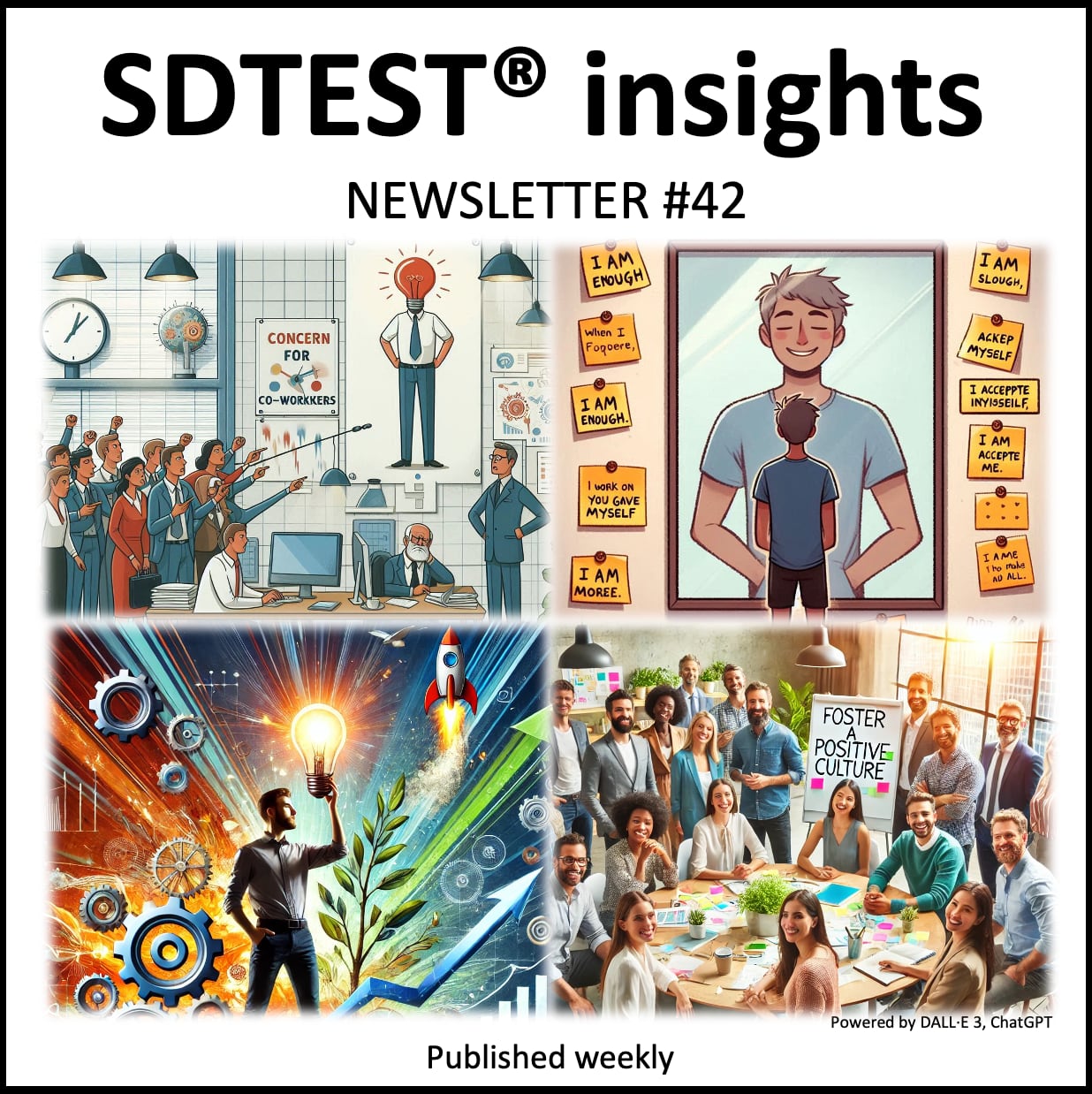SDTEST® has 36 different VUCA polls that calculate the 13,034 correlation values between stages of development according to the theory of Spiral Dynamics and answer options of these 36 polls.
We invite curiosity about the systemic mechanisms behind this correlation. There may be hidden variables that provide alternative explanations.
In our analysis of the poll "Why People Resist Change" (by Siobhán McHale [1]), we found an intriguing positive correlation that warrants closer examination:
0.3491 between the Concern for co-workers and the Purple stage (Germany, three languages).
The critical value of the correlation coefficient for a non-normal distribution, by Spearman r = 0.1624. This positive correlation of 0.3491 meets the reliability criteria but does not necessarily imply causation.

This positive correlation of 0.3491 between Concern for co-workers as a reason for resisting change and the Purple stage in modern Germany offers intriguing insights when viewed through the lens of the Purple value system:
Organizational Perspective:
Organizations operating within the Purple mindset might interpret this correlation as:
- Validation of their tribal-like organizational structure and the importance of preserving established social bonds.
- Confirmation that their emphasis on tradition and group cohesion is deeply ingrained in their workforce.
- Evidence supporting their belief that organizational change threatens the spiritual and communal fabric of the workplace.
These organizations might respond by:
- Implementing change processes that heavily involve spiritual leaders or respected elders within the organization.
- Designing rituals and ceremonies to honor the existing social structure before introducing any changes.
- Promoting leaders who can maintain the organization's spiritual and communal integrity during periods of change.
Team Perspective:
Teams operating from a Purple mindset might approach this correlation by:
- Viewing it as an affirmation of their close-knit, family-like team dynamic.
- Interpreting it as support for their belief that team harmony and unity are sacred and should be preserved at all costs.
- Seeing it as validation for prioritizing the well-being of team members over organizational changes.
These teams might respond by:
- Conducting more ritualistic team-building exercises to reinforce bonds before considering any changes.
- Encouraging team members to share their concerns about change through storytelling or mythical narratives.
- Celebrating instances where the team's unity was maintained despite external pressures for change.
Individual Perspective:
Individuals aligned with the Purple value system might interpret this correlation as:
- Personal validation of their deep-seated loyalty to their work "tribe" and concern for their "work family."
- Evidence supporting their belief that change threatens the sacred bonds they've formed with co-workers.
- Confirmation of the value they place on maintaining harmony and avoiding disruption of the established order.
These individuals might respond by:
- Actively seeking reassurance from spiritual or elder figures within the organization about proposed changes.
- Viewing their ability to maintain and protect workplace relationships as a sacred duty.
- Using their concern for co-workers as a reason to advocate for slower, more cautious approaches to change.
This correlation, viewed through the Purple lens, suggests that those operating at the Purple level in modern Germany are highly resistant to change due to their concern for co-workers. It implies that the Purple value system's focus on community, tradition, and spiritual bonds strongly influences how individuals perceive and react to organizational change.
The reasons why Concern for co-workers might be a significant factor in resisting change in the Purple stage in modern Germany could include:
- Tribal Mentality: The workplace is considered a sacred tribe or clan, and changes threaten the established order.
- Ancestral Wisdom: Some believe that the current way of working was established by wise ancestors and shouldn't be altered.
- Spiritual Bonds: Co-worker relationships are viewed as spiritual connections that organizational changes could sever.
- Ritualistic Work Practices: Changes might disrupt the rituals and routines that give meaning to daily work life.
- Fear of Taboo: Embracing change might be seen as violating workplace taboos, risking spiritual or social consequences.
This correlation prompts us to consider how deeply ingrained cultural values influence attitudes toward organizational change, even in modern, industrialized nations like Germany. It raises questions about the potential benefits and challenges of addressing these Purple-level concerns when implementing change in organizations.
Ultimately, this correlation highlights the complex interplay between traditional values, workplace relationships, and attitudes toward change. In Purple-dominant environments, even in modern contexts, change resistance might be deeply rooted in concerns about disrupting the sacred social fabric of the workplace. This perspective encourages change managers to consider work's spiritual and communal aspects when planning and implementing organizational changes.
In our analysis of the poll "How to regulate your emotions" (by Nawal Mustafa [2]), we found an intriguing positive correlation that warrants closer examination:
0.3582 between When I feel INSECURE. I will work on appreciating and accepting myself, flaws, and all. I am more than I give myself credit for / Moderately Disagree and the Red stage.
The critical value of the correlation coefficient for a normal distribution, by William Sealy Gosset (Student) r = 0.1326. This positive correlation of 0.3582 meets the reliability criteria but does not necessarily imply causation.

This positive correlation of 0.3582 between moderately disagreeing with the statement about self-appreciation when feeling insecure and the Red stage offers intriguing insights when viewed through the lens of the Red value system:
Organizational Perspective:
Organizations operating within the Red mindset might interpret this correlation as:
- Validation of their power-driven, competitive organizational culture.
- Confirmation that their emphasis on strength and dominance discourages self-reflection or acceptance of flaws.
- Evidence supporting their belief that insecurity should be overcome through force or assertion rather than self-acceptance.
These organizations might respond by:
- Implementing more aggressive performance metrics that discourage showing weakness.
- Designing reward systems that favor those who project strength and confidence at all times.
- Promoting leaders who demonstrate unwavering self-assurance and the ability to dominate in all situations.
Team Perspective:
Teams operating from a Red mindset might approach this correlation by:
- Viewing it as an affirmation of their competitive, survival-of-the-fittest team dynamic.
- Interpreting it as support for their belief that showing insecurity or accepting flaws is a sign of weakness.
- Seeing it as validation for prioritizing power plays and dominance over self-reflection or vulnerability.
These teams might respond by:
- Encouraging more confrontational team interactions to "toughen up" members.
- Pushing team members to always project strength and confidence, even when feeling insecure.
- Celebrating instances where team members overcame challenges through force or aggression rather than self-acceptance.
Individual Perspective:
Individuals aligned with the Red value system might interpret this correlation as:
- Personal validation of their belief that showing insecurity or accepting flaws is a sign of weakness.
- Evidence supporting their instinct to react to insecurity with aggression or dominance rather than self-reflection.
- Confirmation of the value they place on projecting strength and power at all times.
These individuals might respond by:
- Actively seeking opportunities to assert dominance when feeling insecure.
- Viewing their ability to mask insecurity with aggression or bravado as a key strength.
- Using their disagreement with self-acceptance as motivation to prove their worth through power or achievement.
This correlation, viewed through the Red lens, suggests that those operating at the Red level are likely to reject notions of self-acceptance and appreciation, especially when feeling insecure. It implies that the Red value system's focus on power, immediate gratification, and dominance strongly influences how individuals perceive and react to feelings of insecurity.
The reasons for feeling INSECURE at the Red stage could include:
- Perceived Threat to Power: Any situation challenging one's dominance or control can trigger insecurity.
- Fear of Weakness: Showing vulnerability or accepting flaws is seen as a dangerous weakness that others might exploit.
- Competitive Pressure: Any perceived shortcoming can feel threatening in a world viewed as a constant battle for supremacy.
- Impulsive Nature: Quick, emotional reactions to situations may lead to frequent feelings of insecurity.
- Lack of Long-term Perspective: Focus on immediate gratification may lead to insecurity about future outcomes.
This correlation makes us consider how deeply ingrained values around power and dominance influence attitudes toward self-acceptance and emotional regulation. It raises questions about the potential costs and benefits of addressing insecurity through power assertion rather than self-reflection in Red-dominant environments.
Ultimately, this correlation highlights the complex interplay between the Red value system's emphasis on power and the experience of insecurity. In Red-dominant contexts, feelings of insecurity are likely to be met with resistance to self-acceptance, instead favoring responses that reassert dominance or strength. This perspective further examines how power-focused value systems impact emotional regulation and self-perception.
-0.3081 between the Sent employees on unpaid vacations and the Blue stage (Netherlands, two languages).
The critical value of the correlation coefficient for a normal distribution, by William Sealy Gosset (Student) r = 0.3042. This negative correlation of -0.3081 meets the reliability criteria but does not necessarily imply causation.
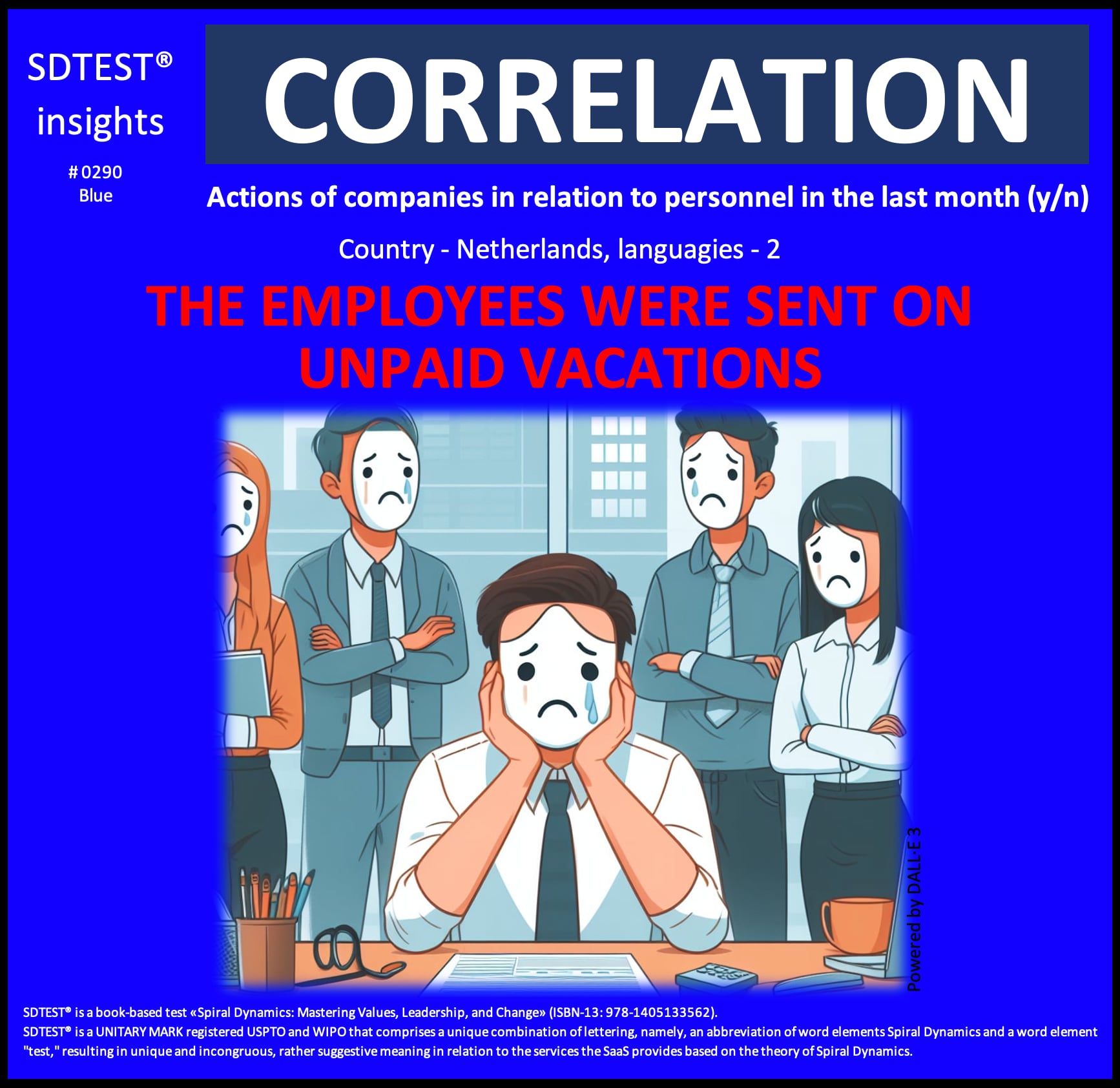
This negative correlation of -0.3081 between sending employees on unpaid vacations and the Blue stage in the modern Netherlands offers intriguing insights when viewed through the lens of the Blue value system:
Organizational Perspective:
Organizations operating within the Blue mindset might interpret this correlation as:
- Validation of their commitment to moral and ethical treatment of employees as dictated by higher authorities or traditional values.
- Confirmation that their emphasis on order and stability extends to maintaining consistent employment practices.
- Evidence supports their belief in upholding societal norms and labor regulations as a principle.
These organizations might respond by:
- Implementing stricter policies against unpaid vacations, viewing them as violating the established order.
- Designing employee retention strategies that align with traditional Dutch labor values and regulations.
- Promoting leaders who demonstrate unwavering commitment to ethical employment practices and societal norms.
Team Perspective:
Teams operating from a Blue mindset might approach this correlation by:
- Viewing it as an affirmation of their collective duty to maintain order and stability within the workforce.
- Interpreting it as support for their belief in the sanctity of established employment contracts and agreements.
- Seeing it as validation for prioritizing loyalty and commitment to the organization and its employees.
These teams might respond by:
- Encouraging team members to report any attempts to implement unpaid vacations as violating organizational ethics.
- Fostering a culture where adherence to labor laws and regulations is seen as a moral imperative.
- Celebrating instances where the team successfully maintained employment stability despite challenging circumstances.
Individual Perspective:
Individuals aligned with the Blue value system might interpret this correlation as:
- Personal validation of their belief in the moral rightness of stable, paid employment.
- Evidence supporting their instinct to resist practices that deviate from established norms and regulations.
- Confirmation of the value they place on loyalty to both their employer and the broader societal structure.
These individuals might respond by:
- Actively opposing any suggestions of unpaid vacations as violating their moral code.
- Viewing their commitment to maintaining paid employment is critical to their duty and responsibility.
- Using their disagreement with unpaid vacations as motivation to uphold and defend traditional Dutch labor practices.
This correlation, viewed through the Blue lens, suggests that those operating at the Blue level in the modern Netherlands will likely reject sending employees on unpaid vacations. It implies that the Blue value system's focus on order, rules, and tradition strongly influences how organizations approach employment practices.
The reasons why employees are not sent on unpaid vacations in the modern Netherlands at the Blue stage could include the following:
- Adherence to Labor Laws: Strict compliance with Dutch labor regulations, which may discourage or prohibit unpaid vacations.
- Moral Obligation: A sense of ethical duty to provide stable, paid employment as part of the social contract.
- Tradition and Stability: Unpaid vacations may disrupt the traditional employment order.
- Fear of Divine or Societal Judgment: Concern that implementing unpaid vacations would be considered morally wrong by higher authorities or society.
- Maintenance of Hierarchy: Unpaid vacations might be perceived as undermining the established organizational structure and roles.
This correlation makes us consider how deeply ingrained values around order, tradition, and moral duty influence employment practices, even in modern, progressive countries like the Netherlands. It raises questions about the potential benefits of maintaining traditional employment practices in Blue-dominant environments, especially in economic uncertainty.
Ultimately, this correlation highlights the complex interplay between the Blue value system's emphasis on order and tradition and modern employment practices. In Blue-dominant contexts within the Netherlands, the resistance to unpaid vacations likely stems from a combination of moral conviction, adherence to established norms, and a strong sense of duty to maintain the traditional employment structure. This perspective further examines how value systems impact labor practices and organizational decision-making in different cultural contexts.
In our analysis of the poll "Real Freedom Is," we found an intriguing negative correlation that warrants closer examination:
-0.2465 between the co-creating reality with others in a spirit of love and compassion / Agree strongly and the Orange stage.
The critical value of the correlation coefficient for a normal distribution, by William Sealy Gosset (Student) r = 0.1138. This negative correlation of -0.2465 meets the reliability criteria but does not necessarily imply causation.

This negative correlation of -0.2465 between strongly agreeing that "Real Freedom Is co-creating reality with others in a spirit of love and compassion" and the Orange stage offers intriguing insights when viewed through the lens of the Orange value system:
Organizational Perspective:
Organizations operating within the Orange mindset might interpret this correlation as:
- Validation of their focus on individual achievement and competitive advantage over collective, compassion-driven approaches.
- Confirmation that their emphasis on measurable results and efficiency aligns with a more individualistic view of freedom.
- Evidence supporting their belief that real freedom stems from scientific and technological progress rather than emotional or spiritual connections.
These organizations might respond by:
- Implementing more data-driven, goal-oriented strategies prioritizing individual performance over collective harmony.
- Designing reward systems that favor tangible achievements and innovations rather than collaborative or compassionate efforts.
- Promoting leaders who demonstrate a solid commitment to rational decision-making and technological advancement.
Team Perspective:
Teams operating from an Orange mindset might approach this correlation by:
- Viewing it as an affirmation of their results-driven, competitive team dynamic.
- Interpreting it as support for their belief that freedom comes from achieving objectives through scientific methods rather than emotional connections.
- Seeing it as validation for prioritizing measurable outcomes over intangible concepts like love and compassion.
These teams might respond by:
- Encouraging more individual contributions and healthy competition within the team.
- Focusing team-building exercises on problem-solving and innovation rather than emotional bonding.
- Celebrating instances where team members achieved breakthroughs through logical analysis and technological solutions.
Individual Perspective:
Individuals aligned with the Orange value system might interpret this correlation as:
- Personal validation of their belief that true freedom comes from individual achievement and self-reliance.
- Evidence supporting their skepticism towards abstract concepts like "co-creating reality" or "spirit of love and compassion."
- Confirmation of the value they place on rational thinking and scientific methods over emotional or spiritual approaches.
These individuals might respond by:
- Actively seeking opportunities to demonstrate their capabilities and achieve personal goals.
- Viewing their ability to make decisions based on logic and data as a critical aspect of their freedom.
- They use their disagreement with the statement to pursue knowledge, innovation, and tangible results.
This correlation, viewed through the Orange lens, suggests that those operating at the Orange level will likely reject the notion that real freedom involves co-creating reality with others in a spirit of love and compassion. It implies that the Orange value system's focus on individuality, rationality, and measurable outcomes strongly influences how people conceptualize freedom.
The reasons why "Real Freedom" is not seen as co-creating reality with others in a spirit of love and compassion in the Orange stage could include:
- Emphasis on Individual Achievement: Freedom is more likely to be associated with personal success and self-reliance.
- Rational Skepticism: Concepts like "co-creating reality" may be viewed as unscientific or lacking empirical evidence.
- Result-Oriented Mindset: Freedom might be seen as the ability to achieve tangible goals rather than cultivate intangible qualities like love and compassion.
- Competitive Worldview: The idea of "co-creating" may be seen as potentially limiting individual potential or competitive edge.
- Technological Focus: Real freedom might be more associated with technological and scientific advancements that expand human capabilities.
This correlation prompts us to consider how deeply ingrained values around rationality, individuality, and measurable outcomes influence perceptions of freedom. It raises questions about the potential limitations of a purely Orange perspective on freedom, especially in an interconnected world facing complex global challenges.
Ultimately, this correlation highlights the complex interplay between the Orange value system's emphasis on individual achievement and scientific progress and more holistic, emotionally-driven concepts of freedom. In Orange-dominant contexts, the resistance to seeing freedom as a collaborative, compassionate endeavor likely stems from a strong belief in personal agency, rational thinking, and tangible results. This perspective encourages a deeper examination of how value systems impact our understanding of freedom and human potential in an increasingly complex and interconnected world.
In our analysis of the poll "Ten Keys to Motivating Your Team," we found an intriguing positive correlation that warrants closer examination:
0.2023 between the Foster a Positive Culture: Cultivate a positive and supportive team culture where members feel valued, respected, and encouraged to collaborate and share ideas openly and the Green stage.
The critical value of the correlation coefficient for a normal distribution, by William Sealy Gosset (Student) r = 0.1636. This positive correlation of 0.2023 meets the reliability criteria but does not necessarily imply causation.
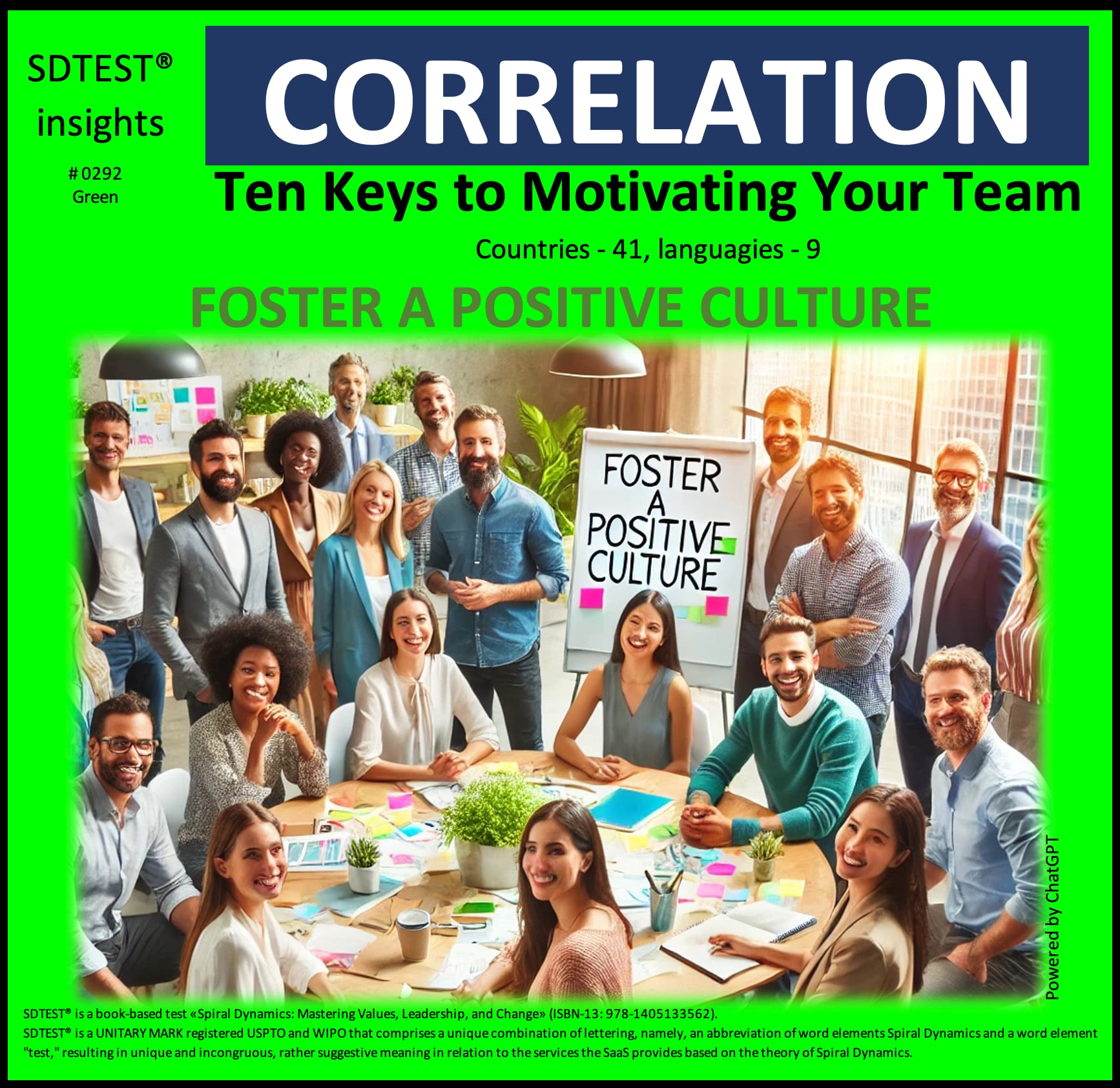
This positive correlation of 0.2023 between "Foster a Positive Culture" as a key to motivating teams and the Green stage offers intriguing insights when viewed through the lens of the Green value system:
Organizational Perspective:
Organizations operating within the Green mindset might interpret this correlation as:
- Validation of their holistic approach to organizational culture that prioritizes well-being and interconnectedness.
- Confirmation that their emphasis on creating inclusive, supportive environments aligns with compelling team motivation.
- Evidence supporting their belief that fostering a positive culture is crucial for sustainable organizational success.
These organizations might respond by:
- Implementing more comprehensive cultural initiatives that emphasize emotional intelligence and interpersonal relationships.
- Designing evaluation systems that value collaboration, idea-sharing, and contributions to team harmony.
- Promoting leaders who demonstrate a solid commitment to creating inclusive, supportive environments and can facilitate open dialogue.
Team Perspective:
Teams operating from a Green mindset might approach this correlation by:
- Viewing it affirms their focus on creating a nurturing, collaborative team environment.
- Interpreting it supports their belief that team motivation stems from feeling valued and respected.
- Seeing it as validation for prioritizing open communication and mutual support within the team.
These teams might respond by:
- Engaging in more frequent team-building exercises that focus on deepening interpersonal connections.
- Encouraging team members to share personal experiences and perspectives to foster empathy and understanding.
- Celebrating instances where positive team culture led to innovative solutions or enhanced collaboration.
Individual Perspective:
Individuals aligned with the Green value system might interpret this correlation as:
- Personal validation of their belief that a positive, supportive environment is crucial for individual and collective motivation.
- Evidence supporting their intuition that feeling valued and respected enhances their ability to contribute meaningfully.
- Confirmation of the value they place on open collaboration and idea-sharing in their work environment.
These individuals might respond by:
- Actively creating a positive culture by practicing active listening and empathy.
- Viewing their ability to foster positive relationships and open dialogue as a key strength in their professional life.
- Using their agreement with the statement as motivation to promote inclusive practices and challenge hierarchical structures.
This correlation, viewed through the Green lens, suggests that those operating at the Green level strongly believe in the motivational power of a positive, supportive team culture. It implies that the Green value system's focus on community, ecology, and holistic thinking aligns well with creating environments where team members feel valued and respected.
The reasons why "Foster a Positive Culture" is seen as a key to motivating teams in the Green stage could include:
- Holistic Perspective: Recognition that team motivation is intrinsically linked to the cultural environment.
- Emphasis on Interconnectedness: Understanding that individual well-being and team success are deeply intertwined.
- Value of Diversity: Belief that a positive culture allows diverse perspectives to be shared and valued.
- Sustainability Focus: Viewing a positive culture as essential for long-term team sustainability and resilience.
- Systems Thinking: Recognizing that culture influences all aspects of team dynamics and performance.
This correlation prompts us to consider how deeply ingrained values around community, inclusivity, and holistic thinking influence perceptions of team motivation. It raises questions about the potential benefits of a Green perspective on organizational culture, especially in complex, diverse work environments facing multifaceted challenges.
Ultimately, this correlation highlights the alignment between the Green value system's emphasis on community and well-being and the belief in the motivational power of a positive team culture. In Green-dominant contexts, fostering a positive culture is fundamental to team motivation, reflecting a deep understanding of the interconnectedness between individual well-being, team dynamics, and organizational success. This perspective encourages a more nuanced, holistic approach to team motivation that goes beyond traditional incentive structures to create environments where all members can thrive and contribute meaningfully.
In our analysis of the poll "Characteristics of a talented employee" (by Talent Management Institute [3]), we found an intriguing negative correlation that warrants closer examination:
-0.1703 between the Entrepreneurial spirit and the Yellow stage.
The critical value of the correlation coefficient for a normal distribution, by William Sealy Gosset (Student) r = 0.1677. This negative correlation of -0.1703 meets the reliability criteria but does not necessarily imply causation.
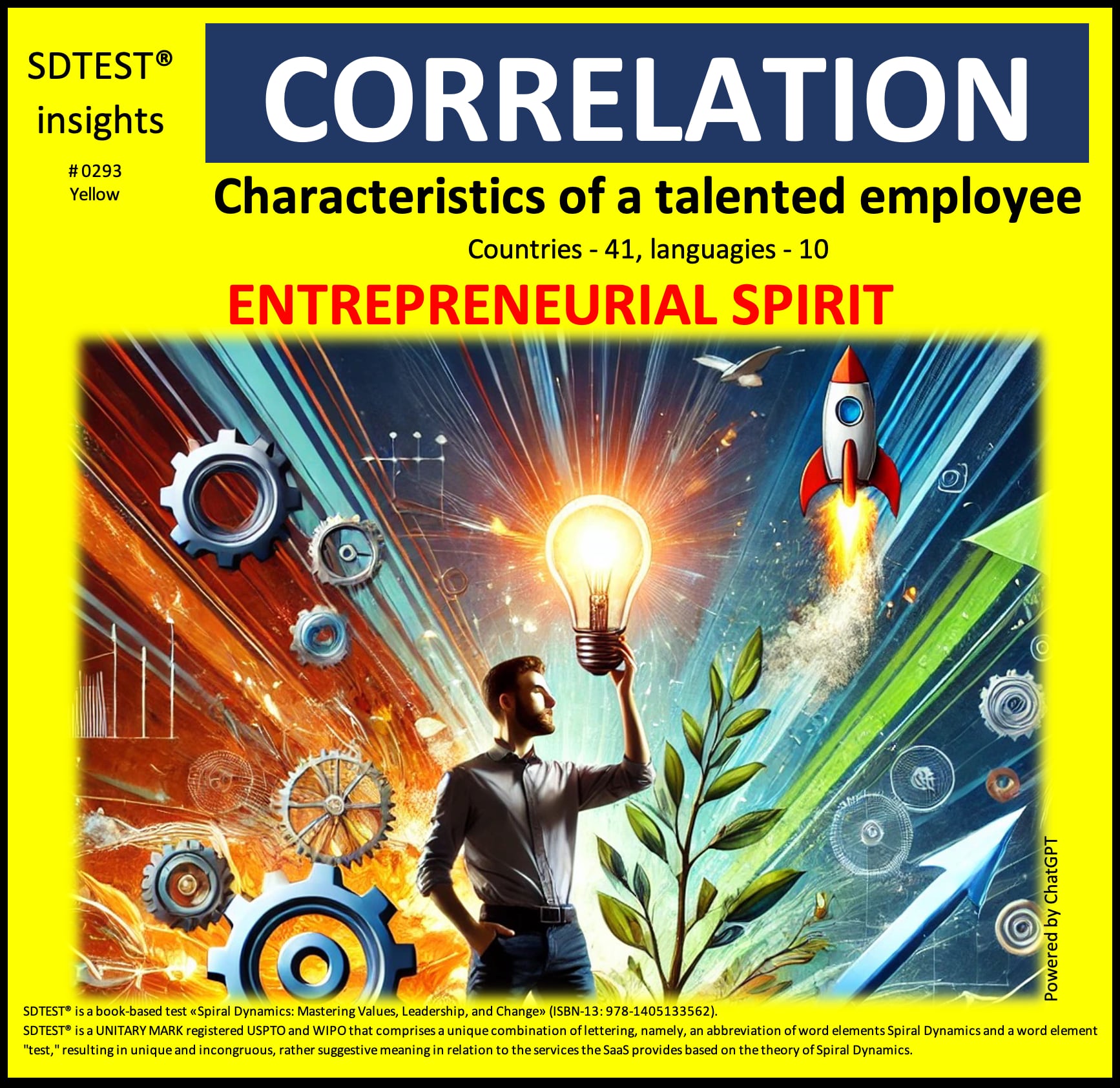
This negative correlation of -0.1703 between "Entrepreneurial spirit" as a characteristic of a talented employee and the Yellow stage offers intriguing insights when viewed through the lens of the Yellow value system:
Organizational Perspective:
Organizations at this level might interpret this correlation as:
- Validation of their integrative approach that values diverse skills beyond traditional entrepreneurial traits.
- Confirmation that their emphasis on systems thinking and adaptability transcends the conventional focus on individual entrepreneurship.
- Evidence supports their belief that talent in a complex world requires more than an entrepreneurial mindset.
These companies might respond by:
- Implement more holistic talent assessment methods that consider an individual's ability to navigate complex systems and integrate multiple perspectives.
- Designing development programs that foster a balance between entrepreneurial skills and other critical competencies, such as systems thinking and adaptability.
- Promoting leaders who can see beyond the entrepreneurial drive to cultivate a workforce adept at handling complexity and change.
Team Perspective:
Teams at this level might approach this correlation by:
- Viewing it as an affirmation of their focus on collective intelligence and interdisciplinary collaboration over individual entrepreneurial efforts.
- Interpreting it as support for their belief that effective teamwork in complex environments requires more than entrepreneurial spirit alone.
- Seeing it as validation for prioritizing diverse skill sets and perspectives within the team.
These teams might respond by:
- Engaging in more cross-functional projects that require the integration of multiple disciplines and viewpoints.
- Encouraging team members to develop broader skills beyond entrepreneurial abilities.
- Celebrating instances where team success came from holistic problem-solving rather than individual entrepreneurial efforts.
Individual Perspective:
Individuals aligned with the Yellow value system might interpret this correlation as:
- Personal validation of their multifaceted approach to personal and professional development.
- Evidence supports their intuition that success in complex systems requires more than entrepreneurial drive.
- Confirmation of the value they place on integrating multiple perspectives and adapting to diverse contexts.
These individuals might respond by:
- Actively seeking opportunities to develop skills that complement or transcend traditional entrepreneurial abilities.
- Viewing their systems thinking capacity and integrating multiple viewpoints as key strengths.
- Using their understanding of this correlation to advocate for more holistic approaches to talent development and assessment.
This correlation, viewed through the Yellow lens, suggests that those operating at the Yellow level see entrepreneurial spirit as just one of many essential characteristics rather than a primary indicator of talent. It implies that the Yellow value system's focus on integration, complexity, and multiple perspectives leads to a more nuanced view of what constitutes talent in modern organizations.
The reasons why entrepreneurial spirit might not be seen as a primary characteristic of a talented employee in the Yellow value system could include:
- Holistic Perspective: Yellow thinkers recognize that talent in complex systems requires many skills beyond entrepreneurship.
- Systems Understanding: They value the ability to navigate and understand complex systems, which may not always align with traditional entrepreneurial traits.
- Integrative Thinking: The capacity to integrate multiple perspectives and approaches is seen as more crucial than individual entrepreneurial drive.
- Adaptability Focus: Yellow values adaptability and flexibility, which may sometimes conflict with the single-minded focus often associated with entrepreneurship.
- Collective Intelligence: There's a recognition that in complex environments, collective intelligence often trumps individual entrepreneurial efforts.
This correlation makes us consider how evolving value systems influence our understanding of talent and employee capabilities. It raises questions about the potential limitations of prioritizing entrepreneurial spirit in increasingly complex and interconnected organizational environments.
Ultimately, this correlation highlights the nuanced view of talent in Yellow-dominant environments. Rather than dismissing entrepreneurial spirit entirely, there's a recognition that it's just one facet of a much broader spectrum of valuable traits. This perspective encourages a more comprehensive approach to talent development and assessment, considering an individual's ability to navigate complexity, integrate diverse viewpoints, and contribute to collective intelligence in ever-changing organizational landscapes.
In our analysis of the poll "Biggest problems facing my country," we found an intriguing positive correlation that warrants closer examination:
0.0683 between the Conditions of infrastructure and the Turquoise stage.
The critical value of the correlation coefficient for a normal distribution, by William Sealy Gosset (Student) r = 0.0486. This positive correlation of 0.0683 meets the reliability criteria but does not necessarily imply causation.
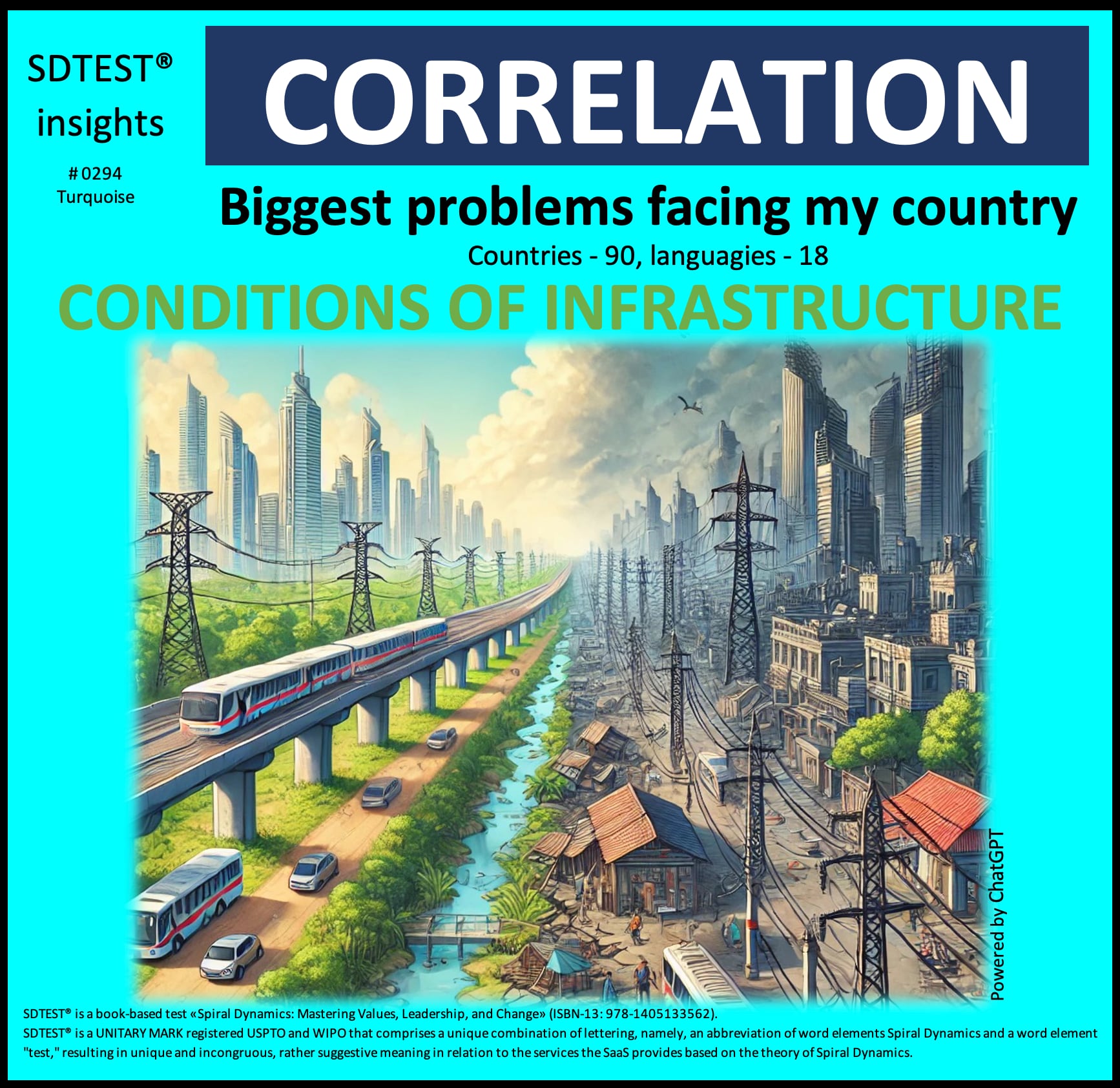
This positive correlation of 0.0683 between the Conditions of infrastructure and the Turquoise stage offers fascinating insights when viewed through the lens of the Turquoise value system:
Organizational Perspective:
Companies operating within the Turquoise mindset might interpret this correlation as:
- Validation of their holistic approach to business that considers the interconnectedness of all systems.
- Confirmation that their focus on sustainable and integrative practices aligns with broader societal development.
- Evidence supporting their belief that infrastructure is a crucial component of a harmonious relationship between human activity and natural ecosystems.
These organizations might respond by:
- Investing in innovative, eco-friendly infrastructure solutions that benefit both their operations and the wider community.
- Implementing decision-making processes that consider the long-term impact of infrastructure projects on all stakeholders, including the environment.
- Collaborating with other entities to create interconnected, sustainable infrastructure networks that transcend traditional organizational boundaries.
Team Perspective:
Teams operating from a Turquoise mindset might approach this correlation by:
- Viewing it as an affirmation of their systems-thinking approach to problem-solving.
- Interpreting it supports their belief that addressing infrastructure challenges requires a holistic, multidisciplinary approach.
- Seeing it as validation for prioritizing projects that enhance the overall well-being of both people and the planet.
These teams might respond by:
- Engaging in more cross-functional collaboration to address complex infrastructure issues.
- Encouraging team members to consider the ripple effects of infrastructure decisions on various interconnected systems.
- Celebrating instances where infrastructure improvements lead to enhanced ecological balance and social harmony.
Individual Perspective:
Individuals aligned with the Turquoise value system might interpret this correlation as:
- Personal validation of their belief in the interconnectedness of all aspects of life, including physical infrastructure and societal development.
- Evidence supporting their intuition that progress towards a more integrated worldview is linked to tangible improvements in the physical world.
- Confirmation of the value they place on creating harmonious living environments that support both human and natural systems.
These individuals might respond by:
- Actively seeking opportunities to contribute to infrastructure projects that align with Turquoise values.
- Viewing their ability to see interconnections between infrastructure and societal development as a valuable perspective in decision-making processes.
- Using their understanding of this correlation to advocate for more holistic, sustainable approaches to infrastructure development in their communities.
This correlation, viewed through the Turquoise lens, suggests that those operating at the Turquoise level may be more aware of and concerned with infrastructure conditions. It implies that the Turquoise value system's focus on integration, sustainability, and holistic thinking aligns with a more comprehensive approach to infrastructure development.
The reasons why the Conditions of infrastructure might be seen as one of the biggest problems facing the country in the Turquoise stage could include:
- Systemic Impact: In the Turquoise stage, infrastructure is considered a critical component of the larger ecosystem, affecting everything from social equity to environmental health.
- Holistic Well-being: Infrastructure is essential for creating living environments that support the well-being of all life forms, not just humans.
- Sustainable Future: The focus on long-term, sustainable solutions in the Turquoise stage highlights the need for infrastructure that can adapt to future challenges.
- Interconnectedness: Infrastructure is recognized as the physical manifestation of societal interconnectedness, making its condition a key concern.
- Ecological Balance: The state of infrastructure reflects our relationship with nature, with poor conditions indicating an imbalance that needs addressing.
This correlation prompts us to consider how evolving value systems influence perceptions of societal challenges. It raises questions about the potential benefits of a Turquoise approach to infrastructure development, particularly in contexts where long-term sustainability and systemic thinking are crucial.
Ultimately, this correlation highlights the complex interplay between cultural values, physical systems, and societal progress. Infrastructure conditions might be seen not just as a technical issue but as a holistic challenge that reflects and influences our collective consciousness and our relationship with the world around us.
What insights do you gain from today's correlation? How might we study this relationship more carefully before deducing causation?
We welcome respectful and wise perspectives! Stay tuned every week as we share more results and insights.
After login or registration, free access to the poll results in the FAQ section.
[1] https://www.linkedin.com/in/mchalesiobhan/
[2] https://www.linkedin.com/in/nawal-mustafa-84a90591/
[3] https://www.linkedin.com/company/talent-management-institute/
2024.10.20
FearpersonqualitiesprojectorganizationalstructureRACIresponsibilitymatrixCritical ChainProject Managementfocus factorJiraempathyleadersbossGermanyChinaPolicyUkraineRussiawarvolatilityuncertaintycomplexityambiguityVUCArelocatejobproblemcountryreasongive upobjectivekeyresultmathematicalpsychologyMBTIHR metricsstandardDEIcorrelationriskscoringmodelGame TheoryPrisoner's Dilemma
Valerii Kosenko
Vlastník produktu SaaS SDTEST®
Valerii získal kvalifikáciu sociálneho pedagóga-psychológa v roku 1993 a odvtedy svoje znalosti uplatňuje v projektovom manažmente.
Valerii získal magisterský titul a kvalifikáciu projektového a programového manažéra v roku 2013. Počas magisterského štúdia sa zoznámil s Plánom projektu (GPM Deutsche Gesellschaft für Projektmanagement e. V.) a Špirálovou dynamikou.
Valerii je autorom skúmania neistoty V.U.C.A. koncept využívajúci špirálovú dynamiku a matematickú štatistiku v psychológii a 38 medzinárodných prieskumov verejnej mienky.

